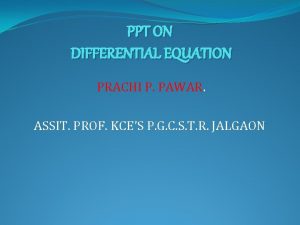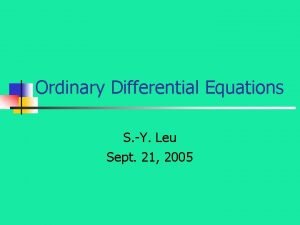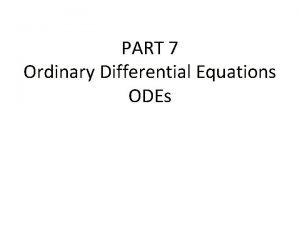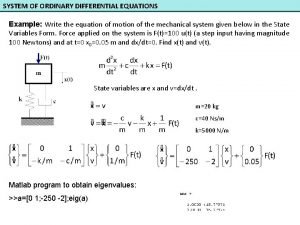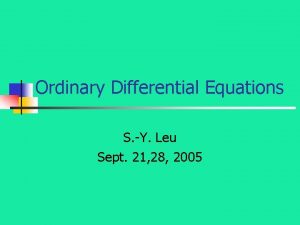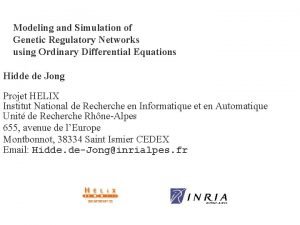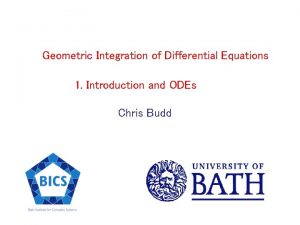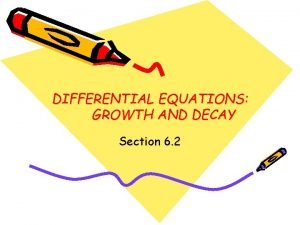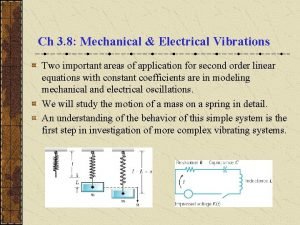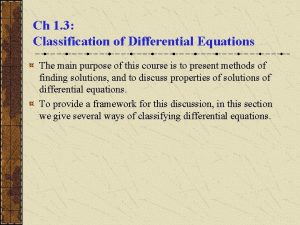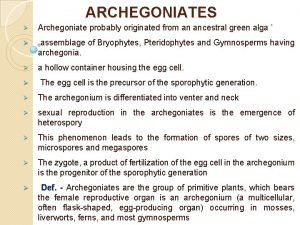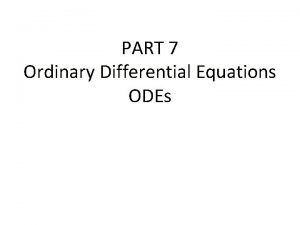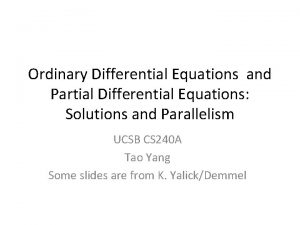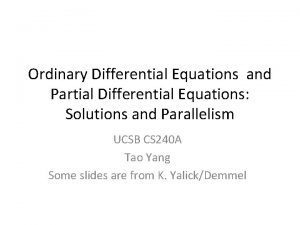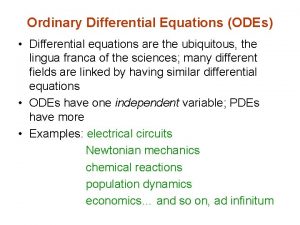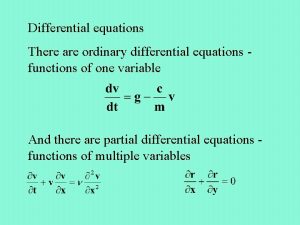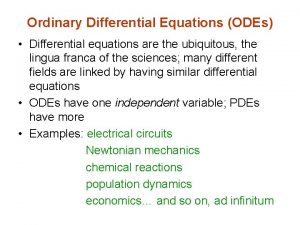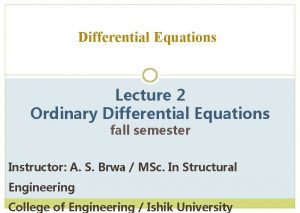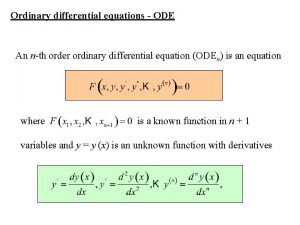The Unifying View on Ordinary Differential Equations and
















- Slides: 16

The Unifying View on Ordinary Differential Equations and Automatic Differentiation, yet with a Gap to Fill Alexander Gofen Conventions Differentiation is understood as for holomorphic functions in the complex plane. Automatic Differentiation is understood as the optimized formulas for n-order differentiation of composite functions (in contrast to non-optimized formulas of Faa di. Bruno). ODEs are specifically regarded as generators of the n-order derivatives and of the Taylor expansion of the solution. Elementary functions are defined wider than the conventional list by Liouville. Elementariness is viewed as a property to satisfy explicit rational ODEs. What was unified?

2 The ideas seemingly unrelated such as… • General elementary functions; • The class of elementary ODEs closed with regard to their solutions; • The transformations of all elementary ODEs to the special formats, enabling. . . • Optimized computability of n-order derivatives, enabling. . . • The modern Taylor integration method as a tool of efficient analytic continuation, revealing… • Special points unreachable via integration of ODEs – the regular points of the solution where the elementariness is violated. …comprise the pieces of one big picture – the Unifying View [2]

3 The two definitions of elementariness: vector elementariness vs. scalar elementariness A vector-function u(t)=(u 1, …, um) is elementary at and near an initial point if it satisfies (generally) a wider system of n≥m rational ODEs uk' = rk(u 1, …, un) ; k = 1, …, n regular at the initial point. Since R. Moore (1960) it is the main definition. The fundamental results in the Unifying view were proved with namely this definition (except one in slide 3. 1 not yet proved for this definition) A function u 1(t) is elementary at and near an initial point if it satisfies a rational m-order ODE u 1(m) = R(u 1, u 1', …, u 1(m-1)) regular at the initial point. The equivalence of both definitions is not established, depending on the not yet proved Conjecture (slide 6). With this definition it is not known how to prove the fundamental results in the Unifying view (except one result in slide 3. 1)

3. 1 New type of special points proven only for the scalar elementariness Theorem: The function [1] and several others (see below) can satisfy rational ODE x(m) = R(x, x', …, x(m-1)) only if it is singular at t=0, hence it can satisfy no polynomial ODE x(m) = P(x, x', …, x(m-1)). This Theorem means that the point t=0 represents a new type of a special point in the function x(t): the point where its scalar elementariness is violated. However it is not known whether its vector-elementariness is violated at t=0 – unless both definitions are equivalent, which takes place if the Conjecture (slide 6) is true. An infinite class of functions similar to x(t) in that their scalar elementariness at t=0 is violated was found. Here are some examples: and also the solution of the IVP tx" - x = 0, x(0) = 0, x'(0) = 1.

4 The gap: A not yet established equivalence between… One n-order rational ODE (in u 1) at a regular point u 1(n) = f(t, u 1', …, u 1(n-1)) and System of m 1 st order rational ODEs at a regular point uk' = gk(t, u 1, …, um) ; k = 1, …, m Here the terms rational and regular are critical. The equivalency does take place if arbitrary holomorphic right hand sides are allowed, and also for rational ODEs if we do not ask regularity of the target ODE at the initial point – see the Table: The target is… Source Target One n-order ODE System of m 1 st order ODEs One regular n-order ODE System of m 1 st order ODEs One possibly singular n-order ODE means “converts into” Rational Holomorphic Yes ? Yes

5 Fundamental transforms of the elementary systems uk' = gk(t, u 1, …, um) ; k = 1, …, m An explicit 1 st order system of ODEs whose right-hand sides gk comprise an elementary vector-function converts to. . . A system of ODEs whose right-hand sides are rational functions. At regular points it further converts to. . . A canonical system: an explicit system of algebraic and differential equations for computing n-order derivatives requiring O(n 2) operations. A system, whose right-hand sides are polynomials. It further converts to. . . Polynomial ODEs of degree ≤ 2. It further converts to polynomial ODEs of degree 2 with. . . with coefficients 0, 1 only (Kerner) …with squares only (Charnyi)

6 The Conjecture (for rational system) Consider an IVP for a source system of m rational ODEs x' = y' = P 1(t, x, y, z, …) Q 1(t, x, y, z, …) P 2(t, x, y, z, …) Q 2(t, x, y, z, …) . . with all the denominators Qi|t=0 ≠ 0 so that the IVP is regular and has a unique solution (x, y, z, …) near t = t 0, in particular the derivatives x(n)|t=t 0 = an , n =0, 1, 2, … Then there exists an explicit rational ODE of some order n x(n) = F(t, x, x', …, x(n-1)) G(t, x, x', …, x(n-1)) x(k)|t=t 0 = ak , k=0, 1, …, n-1 with a denominator G|t=t 0 ≠ 0 so that this ODE is regular at t = t 0 and has x(t) as its unique solution. Or… Or there exists an implicit polynomial ODE H(t, x, x', …, x(n-1), x(n)) = 0 regular at t = 0, meaning H ≠ 0, ( Xn = x(n) ). Xn t=t 0

7 The Conjecture (for polynomial system) Consider an IVP for a source system of m polynomial ODEs x' = P 1(t, x, y, z, …) y' = P 2(t, x, y, z, …). . so that the IVP is regular and has a unique solution (x, y, z, …) near t = t 0, in particular the derivatives x(n)|t=t 0 = an , n =0, 1, 2, …Then there exists an explicit rational ODE of some order n x(n) = F(t, x, x', … x(n-1)) G(t, x, x', … x(n-1)) x(k)|t=t 0 = ak , k=0, 1, …, n-1 with a denominator G|t=t 0 ≠ 0 so that this ODE is regular at t = t 0 and has x(t) as its unique solution. Or… Or there exists an implicit polynomial ODE H(t, x, x', …, x(n-1), x(n)) = 0 regular at t = t 0.

8 The Conjecture (squares only system) Consider an IVP for a source system of m polynomial ODEs x' = a 1 x 2 + b 1 y 2 + c 1 z 2 +… y' = a 2 x 2 + b 2 y 2 + c 2 z 2 +…. . so that the IVP is regular and has a unique solution (x, y, z, …) near t = t 0, in particular the derivatives x(n)|t=t 0 = an , n =0, 1, 2, …Then there exists an explicit rational ODE of some order n x(n) = F(t, x, x', … x(n-1)) G(t, x, x', … x(n-1)) x(k)|t=t 0 = ak , k=0, 1, …, n-1 with a denominator G|t=t 0 ≠ 0 so that this ODE is regular at t = t 0 and has x(t) as its unique solution. For this form in squares only the Conjecture is proved, but only for m=2. Can we ask that the target be explicit polynomial rather than rational n-order ODE?

9 If the Conjecture claimed as though the source system may be converted into an explicit polynomial ODE x(n) = F(t, x, x', … x(n-1)) rather than into an implicit polynomial ODE, the Conjecture would be false! A counter example illustrating this is the entire function x(t) = et - 1 t The function x(t) satisfies the polynomial system of ODEs x' = x – xy + y y' = -y 2 x|t=1 = e - 1 y|t=1 = 1, ( y = 1/t ) (say at t=1), but x(t) can satisfy no polynomial ODE x(n) = F(t, x, x', … x(n-1)) (as proved in 2008 by me and Flanders). Though x(t), as holomorphic function may be analytically continued from t=1 to 0, x(t) cannot be integrated from t=1 to 0 as the solution of the system, because the point t=0 is unreachable due to singularity of y(t) at this point. Conclusion: The target ODE in the Conjecture may be either implicit polynomial or explicit rational only. In a rational ODE the denominator which is nonzero at one point (t, x, x', … x(n-1)), may reach zero at other points of the phase space. To ask for a target ODE with a nonzero denominator presumes that different target ODEs may be required for different initial points of the system.

10 The general setting x' = F(t, x, y, z) y' = G(t, x, y, z) z' = H(t, x, y, z) Conversion from a source system of polynomial ODEs - - to an infinite system of ODEs for x(n) , n=1, 2, … : x' = F 1(t, x, y, z) = F(t, x, y, z) . . . . x(n) = Fn(t, x, y, z) x(n+1) = Fn+1(t, x, y, z) =. . . . Fn t + Fn x x' + Fn y y' + Fn z z' = Fn t + Fn x F+ Fn y G+ Fn z H This infinite system is consistent because it has the unique solution x(t) If F, G, H are … … then F 1, F 2, F 3, …. are … Polynomials Fn of growing degrees Forms of degree 2 Forms; degree of Fn is n+1 Forms in squares only Forms Fn of a special structure

11 The general setting forms in squares only Conversion from a source system of ODEs in squares only x' = F 1(x, y, z) = a 11 x 2 + a 12 y 2 +a 13 z 2 y' = G 1(x, y, z) = a 21 x 2 + a 22 y 2 +a 23 z 2 z' = H 1(x, y, z) = a 31 x 2 + a 32 y 2 +a 33 z 2 - to an infinite sequence of ODEs for x(n) , n=1, 2, … x' = F 1(x, y, z) = a 11 x 2 + a 12 y 2 +a 13 z 2 . . . . x(n+1) = Fn+1(x, y, z)= i=0 Cni(a 11 Fi. Fn-i + a 12 Gi. Gn-i + a 13 Hi. Hn-i) n . . . . where F 0 = x, G 0 = y, H 0 = z, Gn+1(x, y, z)= i=0 Cni(a 21 Fi. Fn-i + a 22 Gi. Gn-i + a 23 Hi. Hn-i) n Hn+1(x, y, z)= i=0 Cni(a 31 Fi. Fn-i + a 32 Gi. Gn-i + a 33 Hi. Hn-i) n

12 Questions about elimination of y, z, … from the infinite system x' = F 2(t, x, y, z, …) . . . . x(n-1) = Fn(t, x, y, z, …) x(n) = Fn+1(t, x, y, z, …) (forms of degree n) . . . . in order to obtain an implicit polynomial ODE P(t, x, x', …, x(n))=0 : The ultimate goal is to eliminate the undesired variables y, z, … picking some m-1 equations of the infinite system, and to ensure that the obtained implicit n-order polynomial ODE P(t, x, x', …, x(n))=0 is not singular at the initial point. Do there exist m equations which are at least invertible in y, z, … at the initial point (the Jacobian J|t=0 ≠ 0) ? - Not necessarily. Say, all x(n) = x = et. Therefore… We can not pick any m-1 equations of the infinite system for the elimination process and be sure that the process succeeds (does not end up with a zero polynomial)? However… For big enough n there always exists an implicit polynomial ODE P(t, x, x', x", …, x(n))=0 such that P(t, x, F 2, F 3, …, Fn+1) is a zero polynomial (see next slide).

13 How that implicit polynomial ODE P(t, x, x', …, x(n))=0 emerges 1… Consider the forms Fn(t, x, y, z, …) of degrees n and their weighted products F 1 a F 2 b …Fnw such that 1 a+2 b+…+nw = n (here F 1= bx+ct). The number of such products is the number of partitions of n, and it grows exponentially like 2 n. Yet every monomial F 1 a F 2 b …Fnw is a form in (t, x, y, z, …) of degree n. The number of monomials in t, x, y, z, … in n-order forms in r variables grows as Cr-1 n+r-1 : slower than the number of partitions. Beginning from a big enough n therefore some subset of monomials F 1 a F 2 b …Fnw must be linearly dependent satisfying the relation aab. . . w. F 1 a F 2 b …Fnw = 0 (all aab. . . w being nonzero), which corresponds to a polynomial ODE P(t, x, x', …, x(n-1))=0. However we do not know which of F 1 a F 2 b …Fnw comprise the basis, and which are dependent. May we ask that for a big enough n, Fn Span{F 1 a F 2 b …Fn-1 t}? (No. That would generate an explicit polynomial ODE x(n-1) = F(t, x, x', … x(n-2)) and we know that it is not always possible). __________ 1) The idea of the proof belongs to the late Harley Flanders

14 Say, an obtained polynomial ODE P(t, x, x', …, x(n))=0 happened to be singular so that P Xn = 0. t=0 Is it possible to modify P = 0 in some way, or to obtain another polynomial ODE Q = 0 (having the same solution x(t) ) so that Q = 0 is regular? - Not via differentiation dk/dtk … If differentiation dk/dtk applies to a singular ODE P = 0 , all the higher order ODEs (d/dt)k. P = 0 will be singular with the same critical factor as above. Otherwise, we can seek another ODE Q = 0 of a higher order and of a higher degree with (unknown) indefinite coefficients asking that the ODE Q = 0 be regular. Then the unknown coefficients of Q are solutions of a certain linear algebraic system (which include the solution for P = 0 ). So far, no progress was achieved in this direction either.

15 Some conclusions • The reported open case about equivalency of a system of ODEs to one n-order ODE could well be posed (or solved? ) already in the 19 th century. The question is so natural that it begs for the answer. • This open case also presents a gap in the otherwise coherent theory – the unifying view on ODEs and AD. Let's unite our efforts and find a proof of the Conjecture! Thank you for the attention References 1. A. Gofen, Unremovable "removable" singularities. Complex Variables and Elliptic Equations, Vol. 53, No. 7, July 2008, pp. 633 -642. (Also here). 2. A. Gofen, The ordinary differential equations and automatic differentiation unified. Complex Variables and Elliptic Equations, Vol. 54, No. 9, September 2009, pp. 825 -854. (Also here). 3. The Conjecture: the surrounding and what is known (2019) The Taylor Center – http: //Taylor. Center. org
 Formation of partial differential equations ppt
Formation of partial differential equations ppt Non linear ode
Non linear ode Ode solution methods
Ode solution methods 1st order derivative formula
1st order derivative formula Ordinary differential equations example
Ordinary differential equations example Non linear ode
Non linear ode Piecewise differential equation
Piecewise differential equation What is ordinary point
What is ordinary point Unifying concepts of animal structure and function
Unifying concepts of animal structure and function Non homogeneous differential equation
Non homogeneous differential equation Munthe sizing
Munthe sizing Exponential differential equation
Exponential differential equation Mechanical and electrical vibrations
Mechanical and electrical vibrations Classifying differential equations
Classifying differential equations Unifying features of archegoniates
Unifying features of archegoniates Unifying themes of biology
Unifying themes of biology The biological hierarchy
The biological hierarchy
